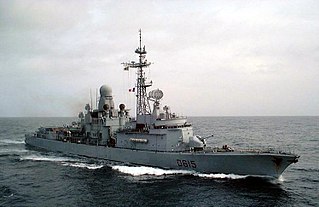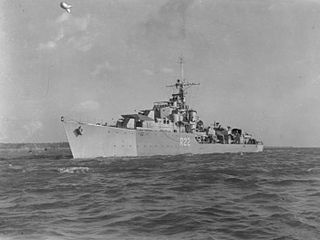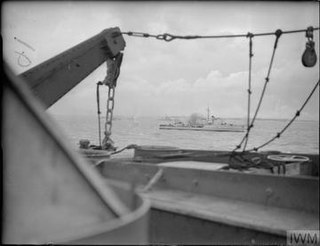
The Type 21 frigate, or Amazon-class frigate, was a British Royal Navy general-purpose escort that was designed in the late 1960s, built in the 1970s and served throughout the 1980s into the 1990s.

The Cassard class was a class of two anti-air warfare destroyers of the French Navy introduced in the latter 1980s/early 1990s. The class was an air defence variant of the Georges Leygues class. The two classes have a different armament and propulsion system mounted on an identical hull. Their primary role was to provide air cover for a fleet, an aeronaval group, a convoy & a littoral point. Their secondary role was to manage air assets coordination & aircraft control for the force, especially through Link 16.They can also be used for research, identification or presence missions. Both ships were assigned to the Force d'Action Navale. The lead ship of the class, Cassard, was retired in 2019 followed by the retirement of Jean Bart in 2021.

The Type 41 or Leopard class were a class of anti-aircraft defence frigates built for the Royal Navy and Indian Navy in the 1950s. The Type 41, together with the Type 61 variant introduced diesel propulsion into the Royal Navy, the perceived benefits being long range, low fuel use, reduced crew, and reduced complexity.

The Type 61 Salisbury class was a class of the Royal Navy aircraft direction (AD) frigate, built in the 1950s. The purpose of the aircraft direction ships was to provide radar picket duties at some distance from a carrier task force and offer interception guidance to aircraft operating in their area.

HMS Grenville was the second ship of this name to serve with the Royal Navy in the Second World War. Grenville and seven other U-class destroyers were ordered as part of the Emergency Programme. She was launched at Swan Hunter and Wigham Richardson Ltd., Wallsend-on-Tyne on 12 October 1942 and commissioned on 27 May 1943.

The Chacal-class destroyer, sometimes known as the Jaguar class, were a group of six large destroyers (contre-torpilleurs) built for the French Navy during the 1920s. Their primary role was scouting for the battleline. All were named for predators: Chacal means jackal, and the other five were named for big cats.
HMS Leopard (F14), was a Leopard-class Type 41 anti aircraft frigate of the British Royal Navy, named after the leopard.

HMS Undaunted was a U-class destroyer of the British Royal Navy that saw service during World War II. She was later converted into a Type 15 fast anti-submarine frigate, with the new pennant number F53.

HMS Undine was a U-class destroyer of the British Royal Navy that saw service during World War II. On 27 March 1945, HMS Undine detached from RN Fast Carrier TF57 to rescue the airmen of a downed RN TBF Avenger aircraft also rescued a USN Corsair pilot adrift for two days south of the Sakishima Gunto in the Philippine Sea.

HMS Ursa was a U-class destroyer of the Royal Navy that saw service during the Second World War. She was later converted into a Type 15 fast anti-submarine frigate, with the new pennant number F200.

HMS Termagant was a T-class destroyer of the Royal Navy that saw service during the Second World War. She was built by William Denny and Brothers, of Dumbarton and launched on 22 March 1943. She was scrapped in 1965.

The Shimushu-class escort ships were a class of kaibōkan built for the Imperial Japanese Navy just prior to World War II. Four ships out of an initially planned 16 vessels were completed. The class was also referred to by internal Japanese documents as the "A-class" coastal defense vessel.

The Etorofu-class escort ships were a group of fourteen kaibōkan escort vessels built for the Imperial Japanese Navy during World War II. Eight of the fourteen ships were sunk during the war. The class was also referred to by internal Japanese documents as the "Modified A-class" coastal defense vessel.

The Mikura-class escort ships were a class of eight kaibōkan escort vessels built for the Imperial Japanese Navy during World War II. Five of the eight ships were sunk during the war. The class was also referred to by internal Japanese documents as the "B-class" coastal defense vessel.

The French destroyer Léopard was a Chacal-class destroyer built for the French Navy during the 1920s. She became a training ship in the mid-1930s before serving as a convoy escort during World War II before the Germans invaded France in May 1940. After that time, she bombarded advancing German forces near the northern French coast and took part in the Dunkirk evacuation. After the surrender of France, she was seized by the British in July and turned over to the Free French.

The Type D escort ships were a class of escort ships in the service of the Imperial Japanese Navy during World War II. The Japanese called them "Type D" coast defence ships, and they were the sixth class of Kaibōkan, a name used to denote a multi-purpose vessel. 143 ships were ordered under the 1943-44 Programme, and a further 57 units were planned under the 1944-45 Programme, for an overal total of 200 ships. However only 67 were completed, with the remainder being cancelled.

HMS Oakley was a Type II Hunt-class destroyer of the Royal Navy. She was originally to have been named Tickham, however she was renamed after her sister ship Oakley was transferred to Poland and was renamed ORP Kujawiak (L72). She entered service in May 1943, carrying out convoy escort, patrol and anti-shipping attacks for most of the rest of the Second World War. She was adopted by the Civil community of Leighton Buzzard in Bedforshire as part of Warship Week in 1942. In 1957, she was sold to the West German Navy, serving as a training ship for the German Naval Gunnery school until scrapped in 1972.

HMS Cottesmore was a Hunt-class destroyer of the British Royal Navy. The ship was built by the Scottish shipbuilder Yarrow at their Scotstoun, Glasgow shipyard in 1939–1940, being launched on 5 September 1940 and commissioning on 29 December that year.

HMS Swift was an S-class destroyer built for the Royal Navy in the Second World War. The ship belonged to the January 1941 order of the Royal Navy from the War Emergency program. The destroyer was launched from the shipyard J. Samuel White in Cowes on 15 June 1943 and was put into service on 12 December 1943.

HMS Serapis was an S-class destroyer of the British Royal Navy. The ship was built by Scotts Shipbuilding and Engineering Company from 1941 to 1943, and was launched on 25 March 1943 and completed on 25 December 1943.


















